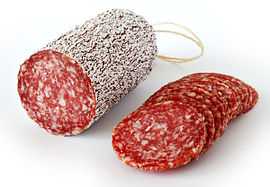Pepperoni

Pepperoni, also known as pepperoni sausage, is an American variety of salami, usually made from cured pork and beef mashed together.[1][2] Pepperoni is characteristically soft, slightly smoky, and bright red in color.[3] Thinly sliced pepperoni is a popular pizza topping in American-style pizzerias[4] and is used as filling in the West Virginia pepperoni roll. It is also used to make some varieties of submarine sandwiches.
Etymology
The term pepperoni is a corruption of peperoni, the plural of peperone, the Italian word for bell pepper. The first reference using pepperoni to refer to a sausage dates to 1919.[3]
Even if in Italian the word is plural (like the Italian word "salami", plural of "salame"), the English word pepperoni is used as a singular uncountable noun.
In Italian, the word "peperoncino" (diminutive of peperone) only refers to hot and spicy peppers, or sometimes to small, sweet kinds, while "peperoni" refers only to sweet peppers, such as bell peppers.
History
Pepperoni is a cured sausage similar to the spicy salamis of southern Italy, such as salsiccia Napoletana piccante, a spicy dry sausage from Naples,[5] or the soppressata from Calabria.[6] The main differences are that pepperoni has a finer grain (akin to salami of Milan, a spiceless regional variant of salami), is usually softer, and is produced with the use of an artificial casing (instead Italian salami are produced using natural gut for casing). Pepperoni is mass-produced to meet the demand for the sausage.
Production
| Nutritional value per 100 g (3.5 oz) | |
|---|---|
| Energy | 1,940 kJ (460 kcal) |
|
4 g | |
|
40.2 g | |
|
20.35 g | |
| |
|
Percentages are roughly approximated using US recommendations for adults. Source: USDA Nutrient Database | |
Pepperoni is usually made from a mixture of pork and beef.[1] Turkey is also commonly used as a substitute, but the use of poultry in pepperoni must be appropriately labeled in the United States.[7] In the Caribbean Islands and other parts of the world, donkey and horse meat is a common ingredient. Sodium nitrite (or sometimes saltpeter),[8] usually a part of modern curing agents, protects against botulism and other forms of microbiological decay. Sodium nitrite itself is white, but reacts to give pepperoni its reddish colour. The use of paprika and cayenne also contribute to its reddish color.
Pepperoni sausages are commonly sold in two sizes: an inch in diameter for pizza and two to three inches in diameter for sandwiches. Pepperoni is sold whole, chopped, or in slices, and is commonly found in American deli counters.
Varieties
Ingredients like peppers, garlic, fennel, or mustard seeds can be included in the production of pepperoni to provide different flavors and levels of spiciness. Likewise, the type of meat used to produce pepperoni can vary. Pepperoni may be substituted by similar cured meats like Genoa salami, soppressata, or chorizo.
Pepperoni has a tendency to curl up from the edges in the heat of a pizza oven. Some pepperoni is produced in thicker slices, so that the edges curl intentionally.[9]
Use on pizza
| Part of a series on |
| Pizza |
|---|
.jpg) |
|
Main articles |
|
Pizza varieties
|
|
Cooking variations |
|
Pizza tools
|
|
Related articles |
|
Similar dishes |
According to Convenience Store Decisions, Americans annually consume 251.7 million pounds of pepperoni on 36% of all pizzas produced nationally.[10]
See also
References
- ↑ 1.0 1.1 "How Food Works: Pepperoni is Raw Meat?". Archived from the original on 2009-02-24.
- ↑ Peery, Susan M. & Reavis, Charles G. Home Sausage Making: How-to Techniques for Making and Enjoying 100 Sausages at Home, third ed. North Adams, Mass.: Storey Publishing, 2003. ISBN 978-1-58017-471-8.
- ↑ 3.0 3.1 Moskin, Julia (February 1, 2011). "Pepperoni: On Top". The New York Times. Retrieved 2013-04-22.
- ↑ "America's Most Popular Pizza Toppings". The Huffington Post. October 5, 2011. Retrieved 2013-04-22.
According to a survey done by Technomic’s MenuMonitor from July to September 2011 based on 235 different pizza places in America pepperoni and plain cheese were the #1 and #2 most popular pizza’s ordered.
- ↑ (Italian) The Agraria.org website
- ↑ (Italian) Website dedicated to products from Calabria
- ↑ Food Standards and Labelling Policy Book, USDA, pp. 133–134.
- ↑ "Homemade Pepperoni Recipe". (From: Home Sausage Making, by Charles G. Reavis, Storey Books). About.com. Retrieved 2013-04-22.
- ↑ López-Alt, J. Kenji (December 11, 2012). "The Food Lab: Why Does Pepperoni Curl?". Seriouseats.com. Retrieved 2013-04-22.
- ↑ "Pizza Palates Changing". Convenience Store Decisions. 2009-06-01. Retrieved 2013-04-25.
Further reading
- Smith, Andrew F. (2007) Entry for Pepperoni. The Oxford Companion to American Food and Drink. p. 447. ISBN 0195307968
- Palumbo, S. A.; (et al.) (January 1976). Microbiology and Technology of the Pepperoni Process (abstract). Journal of Food Science. Volume 41, Issue 1. pages 12–17. (subscription required)
- Palumbo, S. A.; (et al.) (July 1977). Kinetics of Pepperoni Drying (abstract). Journal of Food Science. Volume 42, Issue 4. pages 1029–1033. (subscription required)
External links
 The dictionary definition of pepperoni at Wiktionary
The dictionary definition of pepperoni at Wiktionary Media related to Pepperoni at Wikimedia Commons
Media related to Pepperoni at Wikimedia Commons
| ||||||||||||||||||||||||||||||||||
| |||||||||||||||||||||||||||||||||


